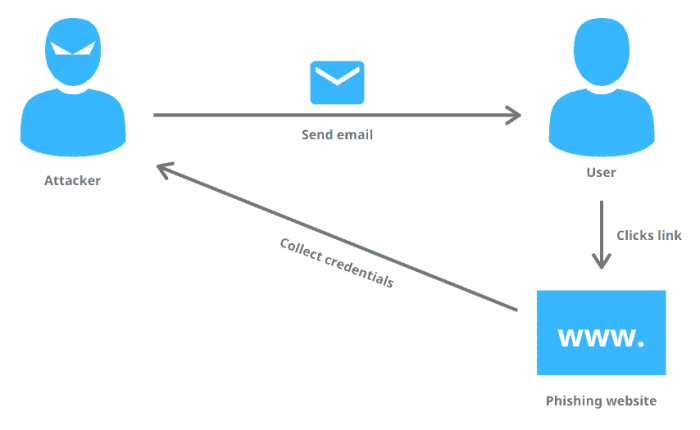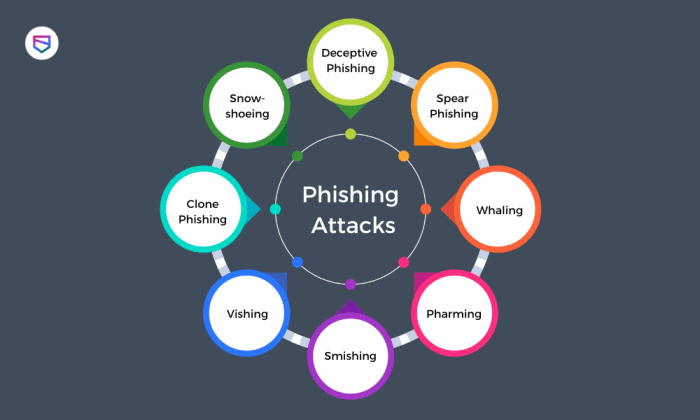Malwareless URL phishing attacks: They sound sneaky, right? And they are. Forget the viruses and malware; these attacks rely on clever deception, tricking you into clicking links that look perfectly harmless but lead straight to a digital trap. We’re talking expertly crafted URLs, social engineering gold, and a whole lot of psychological manipulation. Get ready to uncover the hidden dangers lurking behind those seemingly innocent links.
These attacks bypass traditional antivirus defenses, focusing instead on exploiting human psychology. Think cleverly disguised URLs that mimic legitimate websites, shortened links obscuring their true destination, and phishing emails designed to trigger an immediate, impulsive click. Understanding the techniques behind these attacks is crucial to protecting yourself online. We’ll explore various attack types, from mass phishing campaigns targeting the masses to spear phishing focused on specific individuals, revealing how attackers manipulate trust and exploit human vulnerabilities.
Defining Malwareless URL Phishing Attacks
So, you think phishing is all about dodgy attachments and malware-ridden downloads? Think again! Malwareless URL phishing attacks are a sneaky breed, bypassing traditional antivirus defenses and relying on clever deception to steal your information. They’re all about tricking you into clicking a link that looks legitimate but actually leads to a fake login page or other malicious website designed to harvest your credentials. This is where the real danger lies – and it’s surprisingly effective.
Malwareless URL phishing attacks work by exploiting human psychology rather than relying on malicious code. The attacker crafts a convincing URL that looks identical or very similar to a legitimate website, enticing the victim to click. Once the victim enters their login credentials or other sensitive information on the fake website, the attacker gains access. This entire process happens without any malware being downloaded or installed on the victim’s device. It’s a low-tech, high-impact attack that often goes undetected until it’s too late.
Deceptive URL Techniques
Several techniques are employed to create deceptively similar URLs. These techniques often exploit the limitations of human perception and trust in well-known brands.
| Technique | Description | Example URL |
|---|---|---|
| Typosquatting | Creating a URL that is nearly identical to a legitimate one, differing only by a single letter or character. | http://googl3.com (instead of google.com) |
| Domain Spoofing | Registering a domain name that looks similar to a legitimate domain, using visually similar characters or numbers. | http://goggle.com (using a similar-looking character) |
| URL Shortening Abuse | Using URL shortening services to mask the true destination of a link. | http://bit.ly/fakelink (where the shortened link redirects to a malicious site) |
Social Engineering Tactics
The success of malwareless URL phishing attacks heavily relies on social engineering. Attackers manipulate human behavior to increase the likelihood of victims clicking malicious links. This often involves creating a sense of urgency, fear, or trust.
Here are some common social engineering tactics used in conjunction with these attacks:
- Creating a sense of urgency: Messages often include phrases like “Your account has been compromised! Act now!” or “Limited-time offer! Click here to claim your prize!”
- Exploiting fear: Messages might warn of account suspension, legal action, or other negative consequences if the victim doesn’t click the link.
- Building trust: Attackers might impersonate legitimate organizations or individuals to gain the victim’s confidence. This could involve using official-looking logos, email addresses, or language.
- Using personalized information: Attackers may include the victim’s name or other personal details to make the message seem more authentic and trustworthy.
Types of Malwareless URL Phishing Attacks

Source: springboard.com
Malwareless URL phishing attacks are a sneaky breed, relying on deception rather than malicious code to steal your information. They leverage the power of suggestion and trust, exploiting human psychology to trick victims into handing over sensitive data. Understanding the various types is crucial to building a strong defense. These attacks aren’t monolithic; they adapt and evolve, targeting individuals and organizations in different ways.
The effectiveness of these attacks stems from their simplicity and the widespread reliance on URLs as a fundamental part of online interaction. A seemingly innocuous link can be the gateway to a sophisticated phishing campaign, and the lack of malware makes detection more challenging.
Spear Phishing versus Mass Phishing Campaigns
The difference between spear phishing and mass phishing campaigns using malwareless URLs lies primarily in their targeting strategy. Spear phishing is highly personalized, while mass phishing employs a broader, less targeted approach. This distinction significantly impacts the success rate and the resources required for each attack type.
- Spear Phishing: Highly targeted attacks focusing on specific individuals or organizations. Attackers research their targets extensively, crafting personalized emails and URLs that mimic legitimate communications. The URLs often lead to convincing fake login pages or data-harvesting forms. Success depends on the credibility of the impersonation and the victim’s trust in the source.
- Mass Phishing: Less targeted attacks that cast a wide net, sending out numerous emails with generic or slightly personalized messages and URLs. The success rate is lower than spear phishing due to the lack of personalization, but the sheer volume of attempts can still yield a significant number of victims. Examples include bulk emails pretending to be from popular services or banks, with URLs leading to generic phishing sites.
Shortened URLs and URL Cloaking
Shortened URLs and URL cloaking are common techniques used to obfuscate the true destination of a link, making it harder for users to identify malicious URLs. These methods exploit the human tendency to trust shortened links from familiar sources, without scrutinizing the destination.
Shortened URLs, such as those generated by bit.ly or tinyurl.com, mask the actual URL, making it difficult to assess its legitimacy at a glance. Phishers leverage this to hide the true destination, often a phishing website designed to look like a legitimate site. For example, a shortened URL might appear to lead to a bank’s login page, but actually redirects to a malicious site mimicking the bank’s interface.
URL cloaking, on the other hand, hides the final destination of a link, even after it has been expanded. This advanced technique can be employed to create a deceptive sense of security. Imagine a shortened URL that initially expands to a seemingly innocuous website, only to redirect the user after a short delay to the true malicious destination. This two-step redirection increases the likelihood of success as the initial site might appear legitimate, building trust before the user is redirected to the phishing site.
Detection and Prevention Strategies
So, you’ve learned about the sneaky world of malwareless URL phishing attacks. Now, let’s arm ourselves with the knowledge to fight back. This isn’t about installing a million antivirus programs; it’s about smart strategies and user awareness. Think of it as upgrading your digital immune system.
Effective detection and prevention hinge on a two-pronged approach: educating users to recognize suspicious URLs and employing robust technological tools to analyze links before clicking. This isn’t a battle fought solely by tech wizards; it’s a team effort requiring both individual vigilance and sophisticated security measures.
Security Awareness Training Program
A comprehensive security awareness training program is crucial in mitigating the risk of malwareless URL phishing attacks. This program needs to be engaging, memorable, and regularly updated to reflect the ever-evolving tactics of phishers.
- Module 1: Understanding the Threat. This module will explain what malwareless URL phishing is, why it’s dangerous, and how it differs from traditional phishing. Real-world examples of successful attacks will be used to illustrate the potential consequences.
- Module 2: Identifying Suspicious URLs. This section will teach users how to spot red flags in URLs, such as misspellings, unusual characters, or unexpected domain extensions. Interactive exercises will allow users to practice identifying suspicious URLs in a safe environment.
- Module 3: Safe Browsing Practices. This module will cover best practices for safe browsing, including avoiding clicking on links from unknown sources, verifying sender identities before opening emails, and using strong passwords.
- Module 4: Reporting and Response. This module will Artikel procedures for reporting suspected phishing attempts and how to respond if a user suspects they’ve been targeted.
- Ongoing Reinforcement: Regular quizzes, simulated phishing attacks, and updates on emerging threats will ensure that users remain vigilant and up-to-date on the latest tactics.
Practical Tips for Identifying Malicious URLs
Beyond formal training, individuals can employ several practical techniques to identify potentially malicious URLs. These simple checks can significantly reduce the risk of falling victim to phishing attacks.
- Hover Before You Click: Hover your mouse over a link to see the actual URL in the bottom left corner of your browser window. This allows you to examine the link before clicking, potentially revealing discrepancies between the displayed text and the actual destination.
- Check the Domain Name: Carefully examine the domain name for misspellings or unusual characters. Phishers often use similar-looking domains to trick users (e.g., googl3.com instead of google.com).
- Look for HTTPS: Ensure the website uses HTTPS, indicated by a padlock icon in the address bar. HTTPS encrypts the connection, making it more difficult for phishers to intercept your data.
- Examine the URL Structure: Be wary of unusually long or complex URLs containing excessive parameters or unusual characters. Legitimate websites typically have simpler, more straightforward URLs.
- Use Your Browser’s Security Features: Modern browsers often include built-in security features that can warn you about potentially malicious websites. Pay attention to these warnings.
URL Scanning and Analysis Tools
While user awareness is critical, technological tools play a vital role in proactively identifying and neutralizing malicious URLs. Several URL scanning and analysis tools are available, each with its own strengths and weaknesses.
| Tool Name | Features | Strengths | Weaknesses |
|---|---|---|---|
| VirusTotal | Multi-engine virus scanning, URL analysis, community feedback | Comprehensive analysis, large database of known malicious URLs, free to use | Can be slow, may not detect all zero-day threats, relies on community reporting |
| URLVoid | Blacklist checking, malware detection, phishing detection | Fast scanning, easy to use interface, provides clear results | May miss some newer threats, relies heavily on blacklist data |
| Google Safe Browsing | Integrated into Chrome and other browsers, warns users of potentially harmful websites | Convenient, widely used, regularly updated | Limited information provided, relies on Google’s database |
| Sucuri SiteCheck | Malware scanning, blacklist checking, security headers analysis | Detailed reports, identifies various security vulnerabilities | Not free for extensive use, may require technical expertise to interpret results |
Real-World Examples and Case Studies
Malwareless URL phishing attacks, while lacking the immediate threat of malware infection, are incredibly effective due to their reliance on social engineering and the inherent trust users place in familiar-looking URLs. These attacks often exploit human psychology rather than technical vulnerabilities, making them particularly dangerous. Let’s examine a real-world example to understand their mechanics.
Understanding these attacks requires dissecting the methods used to manipulate victims into revealing sensitive information. The following case study illustrates how subtle manipulations can lead to significant consequences.
A Case Study: The Lookalike URL Attack
This attack targeted employees of a large financial institution. The attackers crafted emails appearing to originate from the company’s internal payroll system. The email contained a link to what appeared to be a legitimate payroll portal, urging employees to update their tax information. However, the URL, while visually similar to the legitimate site, contained subtle differences that were easily missed by a hurried employee.
The attackers’ success hinged on several key deceptive techniques:
- Near-identical URL: The phishing URL was designed to closely mimic the legitimate payroll site’s address. A single character difference or a slightly altered domain name (e.g., using a similar-sounding top-level domain like “.net” instead of “.com”) was enough to fool many users.
- Spoofed Email Header: The email header was meticulously crafted to display the legitimate payroll system’s sender address. This fostered a sense of trust and urgency, encouraging recipients to click the link without further scrutiny.
- Sense of Urgency: The email’s content emphasized the importance of immediate action, suggesting that failure to update tax information would result in penalties or delays in payment. This pressured recipients to act quickly, reducing their likelihood of carefully examining the link.
The chronological breakdown of the attack highlights the efficiency of the attackers’ strategy:
- Email Delivery: Phishing emails were sent en masse to employees of the financial institution.
- Initial Deception: Recipients, seeing a familiar-looking email and sender address, initially believed the email to be legitimate.
- Link Click: Driven by urgency and trust, many employees clicked the malicious link.
- Credential Harvesting: The fake payroll site captured the login credentials (username and password) entered by the victims.
- Data Exfiltration: The stolen credentials were then used to access the legitimate payroll system, potentially compromising sensitive employee data and financial information.
Future Trends and Emerging Threats

Source: mlytics.com
The landscape of online security is constantly evolving, and malwareless URL phishing attacks are no exception. As attackers become more sophisticated, so too must our defenses. The future of these attacks promises to be even more challenging, leveraging advancements in technology to bypass traditional security measures. Understanding these emerging threats is crucial for staying ahead of the curve.
The integration of AI and machine learning is poised to significantly impact both the offensive and defensive sides of this cyber arms race. Attackers can use AI to generate highly convincing phishing URLs and personalize attacks at scale, making them incredibly difficult to distinguish from legitimate links. Simultaneously, AI-powered security solutions are being developed to detect subtle patterns and anomalies in URLs, improving detection rates and response times. However, a constant cat-and-mouse game is expected, with attackers constantly adapting their techniques to circumvent these advancements.
AI-Powered Phishing URL Generation
AI algorithms, particularly generative models like large language models (LLMs), can be used to create incredibly realistic and diverse phishing URLs. These models can learn from vast datasets of legitimate websites, generating URLs that mimic the structure and style of trusted domains. This makes it exponentially harder for humans and even some security tools to identify them as malicious. For example, an AI could generate a URL that closely resembles a popular bank’s website, differing only by a single, subtly altered character or using a similar-sounding domain name. This level of sophistication surpasses the capabilities of simple, manually crafted phishing attempts.
Advanced URL Obfuscation Techniques
Attackers are constantly seeking ways to hide the true nature of malicious URLs. Future trends may involve increasingly complex obfuscation techniques, making it difficult for even advanced security systems to decipher the destination URL. This could involve using techniques like URL shortening services in conjunction with dynamic DNS, creating ever-changing URLs that evade detection. Additionally, the use of steganography, hiding malicious URLs within seemingly innocuous images or text, could become more prevalent. Imagine a seemingly harmless image on social media containing a hidden URL that leads to a phishing site; detection would require advanced image analysis techniques.
Exploiting Zero-Day Vulnerabilities in URL Handling
Attackers may exploit newly discovered vulnerabilities in how browsers and operating systems handle URLs. These zero-day vulnerabilities, unknown to security researchers, allow attackers to bypass standard security protocols and redirect users to malicious sites undetected. Such exploits would be incredibly difficult to mitigate, requiring immediate patching and updates from software vendors. A real-world example could be a vulnerability that allows a malicious script to be executed simply by visiting a specifically crafted URL, circumventing traditional sandboxing and anti-malware techniques.
The Challenge of Contextual Understanding, Malwareless url phishing attacks
Current detection methods often rely on analyzing URLs in isolation. Future attacks will likely leverage contextual information, making detection much harder. This means that the malicious URL’s effectiveness depends on the user’s current context, such as their location, device, and recent browsing history. For example, an attacker might send a phishing email containing a URL that only appears malicious when viewed from a specific geographic location or using a particular type of browser. This contextual approach makes it harder for generic URL scanners to flag the threat accurately.
Closing Notes

Source: wesecureapp.com
In the ever-evolving landscape of cyber threats, malwareless URL phishing attacks represent a significant and persistent challenge. Their ability to bypass traditional security measures underscores the importance of a multi-layered approach to online safety. This involves not only employing robust technical safeguards but also fostering a culture of security awareness and critical thinking. By understanding the techniques used in these attacks and practicing vigilance, we can significantly reduce our vulnerability and navigate the digital world with greater confidence. Remember, a little skepticism can go a long way in avoiding the digital pitfalls.





